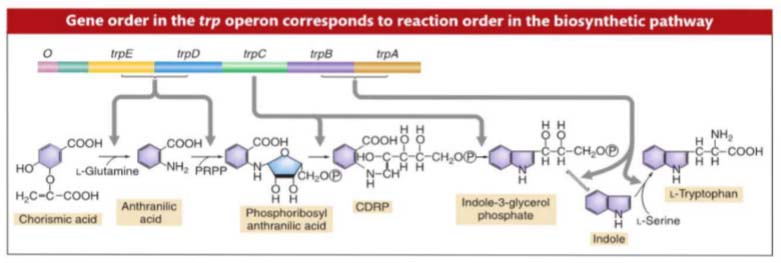Operon:
When a single promoter controls a number of genes.
If tryptophan is present in the environment, then E. coli bacteria don’t need to synthesize it, so transcription of the genes in the trp operon is switched “off.” When tryptophan availability is low, on the other hand, the operon is switched “on,” the genes are transcribed, biosynthetic enzymes are made, and more tryptophan is produced.
trp operon:
The trp operon includes five genes that encode enzymes needed for tryptophan biosynthesis, along with a promoter (RNA polymerase binding site) and an operator (binding site for a repressor protein). The genes of the trp operon are transcribed as a single mRNA.


Figure: Gene order in the trp operon corresponds to reaction order in the biosynthetic pathway The chromosomal order of genes in the trp operon of E. coli and the sequence of reactions catalyzed by the enzyme products of the trp structural genes. The products of genes trpD and trpE form a complex that catalyzes specific steps, as do the products of genes trpB and trpA. Tryptophan synthetase is a tetrameric enzyme formed by the products of trpB and trpA. It catalyzes a two-step process leading to the formation of tryptophan. Abbreviations: PRPP, phosphoribosylpyrophosphate: CDRP, 1-(o-carboxyphenylamino)-1- deoxyribulose 5-phosphate.
Repressor
The DNA is recognized by a regulatory protein known as the trp repressor. When the repressor binds to the operator at DNA it physically block the transcription enzyme.
Repressor Gene ( trp gene switch off)
The trp repressor protein is encoded by a gene called trpR. This gene is not part of the trp operon, and it’s located elsewhere on the bacterial chromosome, where it has its own promoter and other regulatory sequences.
Repressor binds to the DNA only when large amounts of tryptophan are present. there is a site for tryptophan attachement in the repressor.
When tryptophan binds to the repressor it becomes active by changing its shape.
A small molecule like trytophan, which switches a repressor into its active state, is called a corepressor.

trp Gene switch on
When there is little tryptophan in the cell, on the other hand, the trp repressor is inactive (because no tryptophan is available to bind to and activate it). It does not attach to the DNA or block transcription, and this allows the trp operon to be transcribed by RNA polymerase.

In this system, the trp repressor acts as both a sensor and a switch. It senses whether tryptophan is already present at high levels, and if so, it switches the operon to the “off” position, preventing unnecessary biosynthetic enzymes from being made.